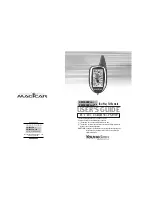
Accessory Input
The AUXiliary Terminal N accepts input signals from load
sharing units, auto synchronizers, and other governor sys-
tem accessories. It is recommended that this connection
from accessories be shielded as it is a sensitive input ter-
minal.
If the auto synchronizer is used alone, not in conjunction with
a load sharing module, a 3
Ω
resister should be connected
between Terminals N and P. This is required to match the
voltage levels between the speed control unit and the syn-
chronizer.
When an accessory is connected to Terminal N, the speed
will decrease and the speed adjustment must be reset.
When operating in the upper end of the control unit frequen-
cy range, a jumper wire or frequency trim control may be
required between Terminals G & J. This increases the fre-
quency range of the speed control to over 7000 Hz.
Accessory Supply
The +10 VDC regulated supply, Terminal P, can be utilized
to provide power to GAC governor system accessories. Up
to 20 mA of current can be drawn from this supply. Ground
reference is Terminal G. Caution: a short circuit on Terminal
P could damage the speed control unit.
Table 3 Variable speed range Potentiometer
Speed Range
Potentiometer
900 Hz
1K
2,400 Hz
5K
3,000 Hz
10K
3,500 Hz
25K
3,700 Hz
50K
Wide Range Remote Variable Speed Operation
Simple and effective remote variable speed can be obtained
with the ESD5550/5570 Series control unit using an external
potentiometer.
A single remote speed adjustment potentiometer can be used
to adjust the engine speed continuously over a specific speed
range. Select the desired speed range and corre-sponding
potentiometer value. (Refer to Table 3.) If the exact range
cannot be found, select the next higher range poten-tiometer.
An additional fixed resistor may be placed across the
potentiometer to obtain the exact desired range. Con-nect the
speed range potentiometer as shown in Diagram 1.
To maintain engine stability at the minimum speed setting, a
small amount of droop can be added turn the DROOP
adjustment CW. At the maximum speed setting the gover-
nor performance will be near isochronous, regardless of the
droop adjustment setting.
Contact GAC for assistance if difficulty is experienced in ob-
taining the desired variable speed governing performance.
Diagram 1 Variable Speed Pot
*
cw
*Select Proper Potentiometer Value from Table 3.
SYSTEM TROUBLESHOOTING
SYSTEM INOPERATIVE
If the engine governing system does not function, the fault may be determined by performing the voltage tests described in Steps 1, 2, 3 and 4. [+] and [-] refer to
meter polarity. Should normal values be indicated as a result of following the troubleshooting steps, the fault may be with actuator or the wiring to
the actuator. See the actual publication for testing details.
Steps
Terminals
Normal Reading
Probable Cause of Abnormal Reading
1
F(+) & E(-)
Battery Supply Voltage 12 or
1.
DC battery power not connected. Check for blown fuse.
24 VDC
2.
Low battery voltage.
3.
Wiring error.
2
C & D
1.0 VAC RMS min., while
1.
Gap between speed sensor and gear teeth too great. Check gap.
cranking.
2.
Improper or defective wiring to the speed sensor. Resitance between Terminals C & D
should be should be 30 to 1200
Ω
.
3
P(+) & G(-)
10 VDC, Internal Supply.
1.
Short on Terminal P. (This will cause a defective unit.)
2.
Defective Speed Control.
4
F(+) & A(-)
1.0 - 2.0 VDC while cranking.
1. Speed Adjustment set too low.
2. Short/open in actuator wiring.
3. Defective speed control.
4. Defective actuator. See Actuator Troubleshooting.
3

























